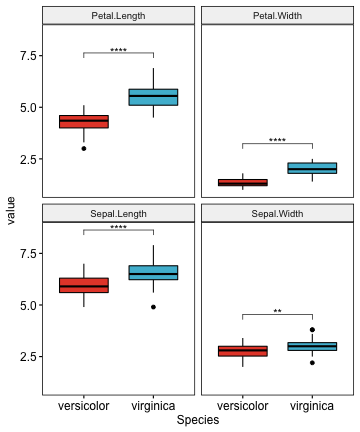
#T.TEST IN R STUDIO HOW TO#
Use our interactive tool to help you choose the right statistical test or read our article on how to choose the right statistical test. Is an unpaired two-sample t-test the right test? To perform one-sample t-test, the R function t.test () can be used as follow: t.test (x, mu 0, alternative 'two.sided') x: a numeric vector containing your data values mu: the theoretical mean. This means that at the 5% significance level, the mean difference falls somewhere between -3.0 and 2.4. The 95% confidence interval for our test is -3.0 to 2.4. This article describes how to do a t-test in R (or in Rstudio). In a t-test, one degree of freedom is “spent” estimating the mean, so the degrees of freedom will be the number of values in the sample minus 1, which in this example is 99. A one-sample t-test is used to compare a sample mean x x (calculated using the data) to a known population mean (typically obtained in previous. The greater the value of the t-value, the more likely it is that the null hypothesis should be rejected.

The t-value measures the size of the difference relative to the variation in the sample data. This indicates that the means of male and female students are equal. The p-value is 0.82 which is above the 5% significance level, therefore the null hypothesis cannot be rejected. Neither of these scenarios is true in our example, but there is probably very little difference in the result of a Welch or student’s t-test. Welch’s t-test is an adaptation of student’s t-test and is useful when the two samples have unequal variances or unequal sample sizes. You will notice that the t.test function has performed a Welch unpaired samples t-test. T = -0.22376, df = 194.96, p-value = 0.8232Īlternative hypothesis: true difference in means is not equal to 0 To get a T statistic, degrees of freedom of the sampling distribution, and the p-value we pass t.test () a vector of data. Let’s say we have a some data on student performance based on gender: set.seed(150) Using the t.test () function If you want to verify that your calculation is correct, R has a function t.test () that performs T-tests and calculates T confidence intervals for means.

The alternative hypothesis is that the means are not the same, which is called a two-tailed test.Īs with a paired t-test, we can perform a one-tailed test where the alternative hypothesis is that the mean of one sample is either higher or lower than the mean of the other. It is sometimes called an independent t-test or independent samples t-test.Īn unpaired two-samples t-test has a null hypothesis that the means of the two samples are the same. An unpaired t-test is used to compare the means of two unrelated groups of samples.


 0 kommentar(er)
0 kommentar(er)
